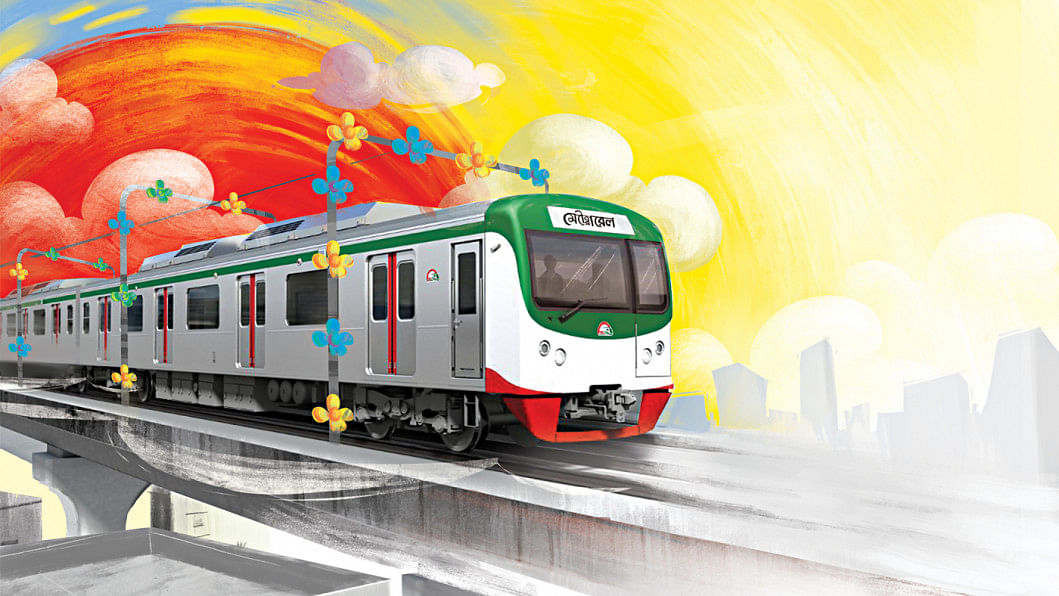Bangladesh ushers in a new era of commuting

Bangladesh is all set to step into a new era of commuting with a new mode of public transport that has never been seen before -- the electricity-powered metro rail of Dhaka.
A portion of the Mass Rapid Transit (MRT) Line-6 project, commonly known as the metro rail, will be inaugurated on December 28, which is expected to partially ease transportation for over 20 million people in the city facing unbridled traffic congestion.
But how did the idea for this highly-technical, yet reliable, public transport project come about?
It was envisaged in 2004 when the government was preparing a "Strategic Transport Plan" (STP) for Dhaka, which was approved in 2005.
The plan was proposed to be combined with the MRT and Bus Rapid Transit (BRT) projects as the city's unplanned traffic network and overloaded transport system continued to worsen the nagging traffic congestion, which, according to a 2018 Buet report, is costing the city an estimated $4.4 billion annually.
With a rapid rise in population and increased land use patterns, Dhaka has grown to become one of the most densely populated cities in the world over the last several decades. However, its development and expansion has been scattered and uneven, resulting in a chaotic traffic system plagued with congestion.
A World Bank report in 2017 estimated that city dwellers were wasting 3.8 million work hours daily due to traffic jams in Dhaka.
While searching for a solution to the traffic congestion problem, the planners realized that the existing public transport system would never be able to meet the growing demand generated by the rapid growth of the city. There was also no room to build new roads.
Therefore, after reviewing experiences from other countries, policymakers concluded that developing a system of urban transport that would meet the basic mobility needs of all urban dwellers at a desirable level of safety and avoid unacceptable levels of congestion was necessary.
With these factors in mind, the Dhaka Transport Coordination Authority (DTCA) prepared the 20-year Strategic Transport Plan (STP) for 2004-2024 in cooperation with the World Bank (WB) in 2005. The plan aimed to transform and develop a more integrated transit system for the rapidly growing capital.
The idea of MRT and BRT came to the fore to offset the lack of road capacity by improving its operational capacity. The main aim of the plan was to change the ecosystem of the public transport system by adding the metro rail and BRT to the existing modes of transport," Professor Shamsul Hoque, a prominent transport expert, told The Daily Star.
Echoing a similar view, Ansiur Rahman, Joint Secretary (MRT-wing) of the Road Transport and Highways Division, said, "As the traditional transport system, like passenger buses, cannot cater to the growing traffic demand, the necessity of the metro rail came in the STP." The STP proposed three BRT lines (BRT-1, 2, 3) and three MRT lines (MRT-4, 5, 6) to alleviate traffic congestion and improve air pollution in the city, thereby contributing to economic and social development and the improvement of the urban environment.
"The most significant result of this approach was that, in order to make the public transit system the most efficient, a number of corridors previously identified for major highway schemes were required for the major mass rapid transit lines," reads the STP document.
"The STP said that over the next 20 years, the population of the Dhaka metropolitan area is expected to more than double, reaching 36 million by 2024. 'In the normal pursuit of their individual lives, these 36 million people will collectively make more than 70 million trips each and every day of the year,' it said.
At the same time, during this same next 20-year period, an estimated Tk 18,000 to Tk 24,000 crore (18-24 billion Bangladeshi taka) will very likely be invested just in the provision of new and improved transport infrastructure in the Dhaka area, according to the STP document.
In 2009-10, the Japan International Cooperation Agency (JICA) conducted the Dhaka Urban Transportation Network Development Study (DHUTS) with the DTCA to conceptualize basic urban development scenarios for Dhaka city up to 2025 and to select priority projects. The study recommended the prioritization of constructing the MRT Line-6, said experts and project officials.
According to the STP, the three MRT lines and BRT lines were supposed to commence before 2010 and be completed in 2024. However, except for MRT Line 6 and BRT Line 3, none of the projects stated in the STP could start before 2012, so the STP was reviewed and updated in 2016."
By this time, the situation in Dhaka city's infrastructure and road traffic scenario had changed significantly. For example, the Dhaka City Corporation started building a flyover over Gulistan, Jatrabari, and Sayedabad which appeared as a major obstacle for several BRT and MRT projects proposed in the original STP.
On the other hand, a long delay and bad experience in building the BRT line from Shahjalal International Airport in Dhaka to Gazipur forced the authorities to think differently about developing BRT lines inside Dhaka.
Amid this situation, the revision work of the STP was done in 2016, proposing five MRT lines (MRT-1, 2, 4, 5, 6 with two routes in line-5) and two BRT lines (BRT-3 and 7).
The 31.24km MRT Line-1 will have two parts: a 19.87km part from Hazrat Shahjalal International Airport, Khilkhet, Badda, Rampura, and Malibagh to Kamalapur (Airport route) which will be underground and an around 11.36km elevated line from Notunbazar to Purbachal (Purbachal route). The construction work of the Tk 52,561.43 crore project, the biggest infrastructure project in the transport sector and the first underground metro, is expected to start by February next year.
The MRT-2 will have both elevated and underground sections, starting from Gabtoli and touching Basila, Mohammadpur, Jigatola, Science Lab, Nilkhet, Azimpur, Central Shaheed Minar, Police Headquarters, Gulistan, Motijheel, Arambagh, Kamalapur, Manda, Signboard, Bhuigor, Jalkuri, Narayanganj. The route will have an extension part from Gulistan to Sadarghat. The MRT-2 project is yet to be approved.
The MRT Line-6 project was approved as a priority project in December 2012 at a cost of Tk 21,985 crore. In June 2013, the government formed the Dhaka Mass Transit Company Limited to implement the projects and operate the metro rail service. The parliament passed the Metro Rail Act in 2015, bringing all metro rail-related work under a legal framework.
The MRT-4 was initially designed to be built under the existing Dhaka-Narayanganj rail line, but the authorities recently made a change in the route as the Bangladesh Railway is expanding its network on this route. As a result, the new alignment for MRT-4 will be from Kamalapur to Madanpur on the Dhaka-Chattogram Highway. Like MRT-2, this project has not been approved.
The MRT-5 will have two routes – a northern and a southern route. The northern route will start from Savar's Hemayetpur in the western part of the capital and go to Bhatara in the eastern part, passing through Gabtoli, Dar-us-Salam, Mirpur-1, Mirpur-10, Mirpur-14, Kochukhet, Banani, and Gulshan. The 20km line with 14 stations will consist of both underground and elevated sections. The 41,239 crore project was approved in October 2019 and the physical work is likely to start next year.
The 17km MRT Line-5 (southern route) will have both elevated and underground sections. The possible alignment will be Gabtoli, Technical, Kallyanpur, Shyamoli, Asad Gate, Russel Square, Panthapath, Karwan Bazar, Hatirjheel, Niketon, Rampura, Aftabnagar, and Dasherkandi. The project is yet to be approved.
Once completed, the metro rail lines are expected to serve around 5 million people every day in Dhaka by 2035.
MRT-6: THE PRIORITY ONE
Meanwhile, the MRT Line-6 project was approved as a priority project in December 2012 at a cost of Tk 21,985 crore. The project was supposed to be completed by June 2024. In June 2013, the government formed the Dhaka Mass Transit Company Limited to implement the projects and operate the metro rail service. The parliament passed the Metro Rail Act-2015 in 2015, bringing all metro rail-related work under a legal framework. Prime Minister Sheikh Hasina inaugurated the construction work of the country's first metro rail in June 2016.
Around this time, the authorities prepared a time-bound action plan to build a 130km metro railway network in and around the capital by 2030 to reduce traffic congestion and environmental pollution.
The work on the MRT Line-6 began with the development of the depot area at Diabari in Uttara in September 2016. The 20.1km elevated line goes through Pallabi, Mirpur-10, Agargaon, Farmgate, Karwan Bazar, Shahbagh, TSC, and Jatiya Press Club, and ends at Motijheel with 16 stations.
The authorities later decided to extend the route to Kamalapur from Motijheel, making the total length of the line 21.26km with one more station. They also made changes to the design of some station areas and revised the project cost, increasing it to Tk 33,472 crore from Tk 21,985 crore.
Now, a 12km portion from Uttara to Agargaon will be inaugurated on December 28. The 8km portion from Agargaon to Motijheel is expected to launch in December next year. The remaining 1.16km portion from Motijheel to Kamalapur is expected to be completed by June 2025.
Joint Secretary Anisur Rahman, who has been involved with the MRT project in various capacities for a long time, said that the metro rail is a high-quality public transport that will give people the certainty of arriving at their destination on time, which is not possible with the traditional mode of transport. He added that once completed, the metro rail will bring about a significant change in our culture of using public transport.


 For all latest news, follow The Daily Star's Google News channel.
For all latest news, follow The Daily Star's Google News channel. 



Comments